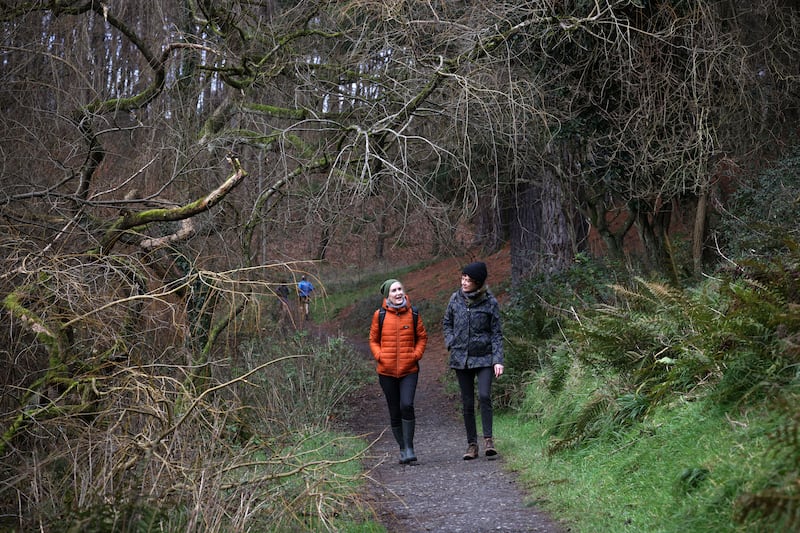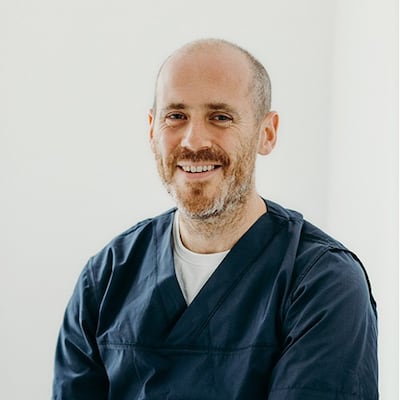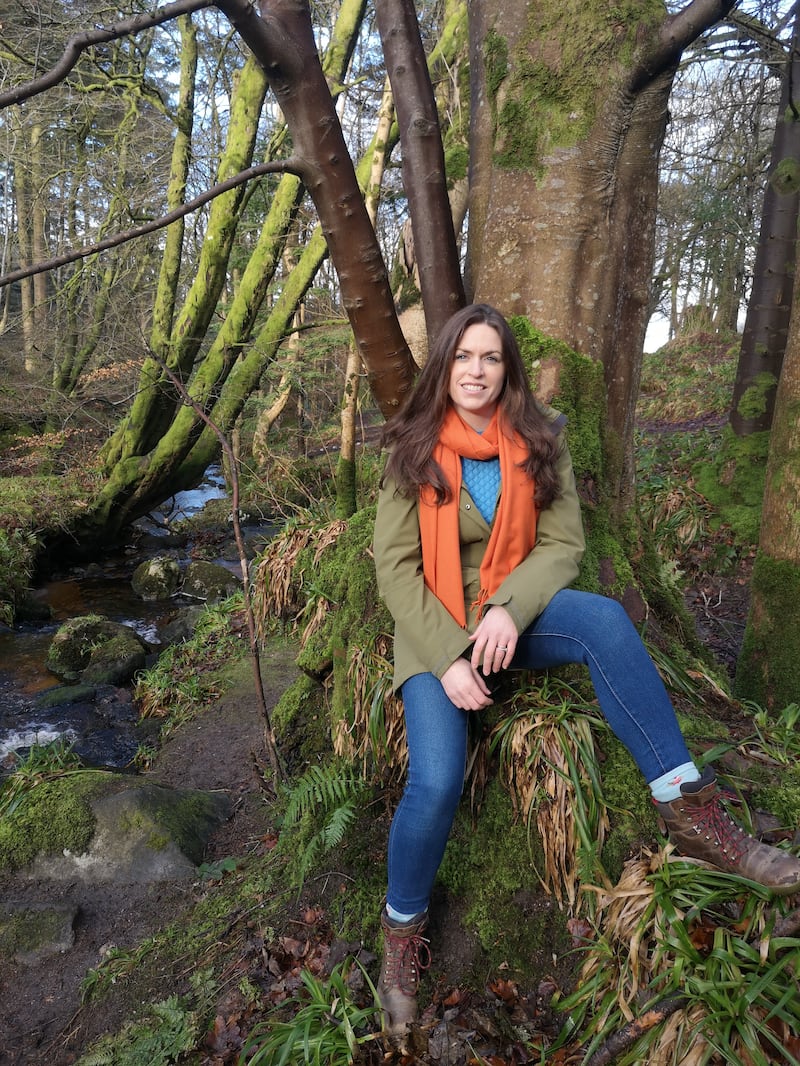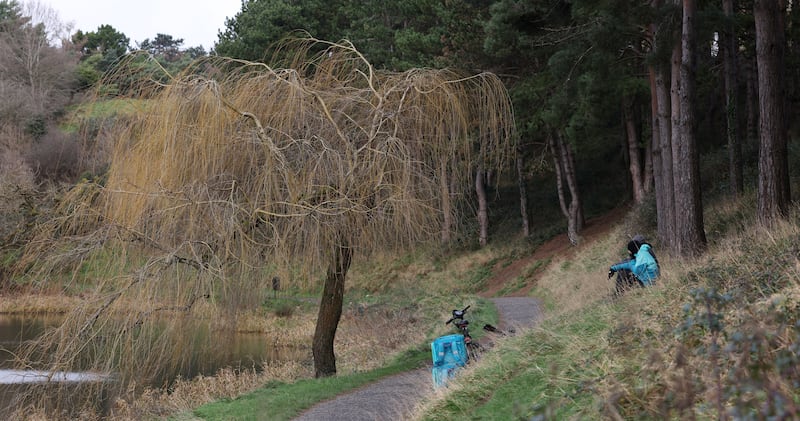I’ve left the house too late and have to tear up through Phoenix Park on the bike. Dressed for cold and rain I arrive a hot mess, inadvertently in need of a calming dose of nature. I join ecologist Anja Murray and we walk down the steep hill from the Upper Glen Car Park. In the hollow there is a small woodland, a pond, some ducks and birds. It’s as woolly and wild a place as you’ll find in a city.
“There’s so many different colours and textures,” Murray says. “It’s midwinter, but these stalks are kind of gorgeous when you pause and look at the fluffy textures.”
It’s that gentle act of “pausing and looking” that makes the next half an hour feel like one of the most restorative of the year. I run and cycle in this park all year, but pausing and looking has not featured in any of those activities. We watch the branch of a towering Scots Pine nod up and down with the breeze, looking at it with what Murray describes as “soft fascination”.

This is a way of looking that “brings us out of our over-focusing, overthinking minds. You can almost feel your shoulder blades sink back down your back. That’s the kind of thing that does lower your heart rate, is deeply relaxing,” she says, of this soft fascination with “those patterns and textures”.
READ MORE
There is a growing body of evidence that links our physical and mental health with the time we spend in nature. Ironically, the research grows while we humans destroy the natural world with lethal speed and efficiency. It’s as if we are on a tree sawing the branch off under us, while simultaneously starting to appreciate its strength and support.
The American ecologist Edward O. Wilson popularised the word “biophilia” with his 1984 book of the same name. Coming from Greek and meaning a “love of life”, biophilia is our “innate tendency to focus on life and life-like processes”. A yearning for nature is genetically hardwired into us, Wilson argued. “From infancy, we concentrate happily on ourselves and other organisms,” he wrote. “We learn to distinguish life from the inanimate and move towards it like moths to a porch light.”
Wilson was an unapologetic naturalist. “My attention was on the forest. It has been there all my life,” he wrote. “I can work up some appreciation for the travel stories of Paul Theroux and other urbanophile authors who treat human settlements as virtually the whole world and the intervening natural habitats as troublesome barriers… I have thought exactly the opposite. Jungles and grasslands are the logical destinations, and towns and farmland [are] the labyrinth that people have imposed between them sometime in the past. I cherish the green enclaves accidentally left behind.”

This hollow in Phoenix Park feels a little like an enclave. Tiny birds hop around the branches of a winter-bare shrub, bursts of feathery joy in the winter drear. The “big piece” for Murray is not just how much we can get from nature, but also how much the natural world needs us to pay attention.
“One-third of our native bees are threatened with extinction. Sixty per cent of Irish birds are either orange or red listed. Half of our rivers are polluted… things are really bad. It’s a bit of a battlefield and that’s depressing. It’s overwhelming, and it makes most of us just turn away altogether from any kind of engagement in the environment.”
She wrote her recent book Wild Embrace because of the “massive benefits” of rebuilding our connections with nature. “Time in nature makes us feel more connected. It gives us a mental resilience to be able to keep engaging in the issues as well so we’re not as likely to put our head in the sand and turn away from it. So it’s not just about a walk in the park being great. It’s crucial for being able to engage with the challenge of climate change and biodiversity loss.
“There are big differences between a very biodiverse environment, a manicured lawn or a monoculture ryegrass field. It’s not going to have the same mental health benefits. There’s not as much to see. But even in a city, we can walk through an old abandoned laneway and look up and see a wall full of ferns and incredible fractal patterns. We can see buddleia bushes coming out of derelict sites. We can go to a wasteland and sometimes see amazing things.”
In the middle of biodiversity and climate crises, what’s really nice is that acting on climate change is asking us to be our best selves
— Louth GP Seán Owens
Murray’s fascination for finding the jungle in the urban jungle echoes E.O. Wilson’s theory that we are born with an instinct for nature. “We think of it as childish or immature or irresponsible,” she says. “I stop in the street often. There might be a little flock of sparrows and I’ll look at them. People give you odd looks, or if you bend down with a hand lens to look at a clump of moss, bum in the air. People see it as self-indulgent or childish, and it’s not. It’s so crucial. It’s terrible that it’s framed as being kind of childish. Curiosity is so important for our mental wellbeing, and makes us cleverer.”
She uses a nature fix to jump-start her brain when it stalls. “If I’m a bit stuck on something I’m writing I’ll go for a walk, look at some tree bark, look at some leaves, watch some birds. I’ll come back and voom right into it. Problem solved. There’s evidence to back that up. There’s neuroscience that problem-solving and creative thinking are all enhanced by spending time in nature.”
Chief among the environmental neuroscience experts is University of Chicago Professor Marc Berman. In a Michigan study, Berman gave a group of students a task to listen to a sequence of between three and nine numbers, and then repeat them back in reverse order. Asked to do the test twice, students scored significantly better after a 50-minute walk in the Ann Arbor Arboretum. They also improved their score after the same length of time walking on a traffic-heavy street lined with university and office buildings. But the brain boost they got from walking in the treeless street was nowhere near as good as the walk in the park.
Multiple studies show nature helping us to think better and feel better. If it came in a bottle, the benefits would barely fit on the label. Positive, reflective thinking increases, we feel less aggressive, and spend less time ruminating. Creative performance increases when creative people work in places with images of nature on the walls; design students generate more creative solutions working in a natural space compared to a conventional classroom.
Berman’s memory study suggested that we feel soothed by nature because living things like ferns and branches, tiny mosses and lichens and patterns on a tree trunk do not demand what’s called directed attention in the same way that our angular urban environments do, with all their stimuli of traffic, advertising and other activities. So when we return to tasks that require that directed attention, our capacity has been restored rather than depleted. In the give-get transaction, we get so much more from letting mother nature do her work on us.

For Louth GP Seán Owens, these health connections have provided “an awakening”. As a former community pharmacist he came from the “pill for an ill model”. He retrained as a GP, which was “still in the field of diagnosis and cure and therapies, very little in the way of prevention”.
Lifestyle interventions are by far the best for our health, he explains. There are six pillars: substance minimisation, exercise (balance, resistance and cardio), diet, social connection, sleep and stress management (using mindfulness and meditation).
Through his work with the Climate and Health Alliance and Irish Doctors for the Environment, he believes our health is “totally dependent on high value nature”. A better understanding of nature’s benefits can help us face future challenges. “In the middle of biodiversity and climate crises, what’s really nice is that acting on climate change is asking us to be our best selves. Nothing can touch exercise for cancer prevention, nothing can touch a plant-based diet for prevention of heart disease.”
The “softer drives” of using nature as a prescribed additional therapy, sometimes called green prescribing, came into focus during Covid when he discovered a veteran elm tree at the back of the GP practice where he works, and began suggesting to patients they go and take a look at it as they waited.
This month he will begin a more formal green prescribing project. Working with Mental Health Ireland occupational therapist Niamh Ní Conghaile, a group of up to 12 patients will be prescribed a “guided walk through the woods” followed by a cup of tea. The big challenge is “where are the trees?” he says, but he’s certain they will find some on the nearby Cooley Mountains.
Indigenous communities talked about Mother Earth, valuing future and past generations. We have a four-year election cycle
— GP Seán Owens
He takes regular dives into the research on websites like nhsforest.org, an alliance of more than 360 healthcare sites across the UK working to transform their green spaces to promote more engagement with nature. “It’s so new but all so relevant,” he says. Nature can “increase your resilience, decrease your stress hormone, improve your mood, lower your heart rate. It’s very good for your microbiome [the community of microbes we carry in our bodies]. It’s very different and humbling. The more you read into it the more you get a sense of awe. What’s working? Is it the shapes, the smells, the microbes?”
We need to protect natural environments, increase them and make them available, he says. “Indigenous communities talked about Mother Earth, valuing future and past generations. We have a four-year election cycle.”
Does he personally use nature as a cure? “Like most GPs I work long hours so I have to engineer it into that. I cycle to and from work, drop the kids and cycle through the park. I grab it here and there. A house call at lunchtime is a time to have some sky above you.”
Chartered clinical psychologist Olivia Murphy was getting her “dose of trees” in Massy’s Wood near the Hellfire Club in the Dublin Mountains when I contacted her. After training in the “cognitive heavy” world of clinical psychology, she found herself coming “back to the body” and its innate ability to heal. In many ways, our fractured relationship with nature is mirrored in our disconnection with our own bodies. “It was like an acknowledgment of the disconnection, an ‘oh hello I’ve missed you’” moment for her, both personally and professionally, she says. We override our body’s needs on a daily basis to reach deadlines. “There might be busy days when I realise ‘God I haven’t even gone to the loo,’” she says.

She contacted nature and wellbeing consultant Shirley Gleeson at the Nádúr Centre for Integrative Forest Therapy and trained first in forest bathing, an evidence-based technique much in use in Japan, and then did a further course in Integrated Forest Therapy. As part of the training she worked with a group of cancer patients in remission. “It was amazing to see the impact week to week.” She guided woodland walks for the group, but not the kind of power-walking, arm-swinging, cover lots of ground walks we associate with hikes. “Slowing down is a big thing with my work, to use our senses to connect back.” She feels it’s like a “coming back to myself” to tap back into the natural rhythms of life, “hibernating in the winter season and being okay with that, retiring from the world, listening to my body’s rhythms.” There are five pathways to reconnect to nature: compassion, meaning, beauty, emotion and the senses, she explains.
When you’re in a state of chronic stress, your immune system goes down
— Clinical Psychologist Olive Murphy
When the connection is mended there are physiological and relaxation benefits. Our immune systems function better. “When you’re in a state of chronic stress, your immune system goes down.” Micro stresses, like the email that makes your heart pound, or a car narrowly avoiding you, all release “the fight or flight response” in our bodies. “The body doesn’t know it’s okay. It’s slower than the mind in catching up.” Much of her work with patients is training them to “feel what we’re feeling and let the sensation arise and fall.” Unless that happens, the stress “gets stored”.
One of the aspects that came up during her training was the inequality of access to nature, how to find nature in a more urban setting, or make it accessible to people with mobility issues. It is possible, she says, to have micro moments, a snack rather than a full meal, by inviting someone to have a mindful connection with a leaf or the smell of soil. (That inequality issue has been one of the main drivers of my work with Pocket Forests.) Having plants in an office or clinic room is a good start. When working with teenagers she often asks, “do you have a favourite place in nature, do you have a photo of it? How do you feel looking at it?” It all helps to regulate our body’s emotional response.
For over a decade, surfer and marine social ecologist Easkey Britton has been researching the benefits of water environments for our health. “As someone who has surfed, I know how beneficial it’s been in supporting my health, not just physically but psychologically,” she says. That playful ability to “access a whole new world,” and better understand the human relationship with the sea came naturally to someone who’s been “standing on a surfboard from the age of four”.
“Blue health is an emerging discipline, and there’s now a whole language around it… really we’re just scratching the surface. Why is it we’re drawn to water?” There’s something called the blue mind effect, coined by Wallace J Nichols in his 2015 book Blue Mind, she says. It shows that brain waves are altered by time in water, so they mimic patterns “similar to prolonged meditation”.
“We know water can have a direct effect on our brain health, especially cold water, which affects our neurochemical cycles and hormonal balances.” Studying the relationship between a healthy environment and its effect on our health felt “very niche” until Covid hit and many people started swimming outdoors. Britton hasn’t seen a huge fall off in numbers. There are still people of all ages surfing, and every hour of every day she sees people taking to the sea where she’s based in Rossnowlagh, Co Donegal.
Her latest book Ebb and Flow explores the unique relationship we can have with nature through water. What does she get from immersion? “For me personally, why blue environments can be so potent, so dynamic is that they’re always changing. I can meet myself wherever I am. It’s a permission space to feel all that I’m feeling, and it’s especially healing for the release of powerful emotions like grief or depression.” It’s important that people find safe spaces to access water, and she loves the emergence of swimming pods, groups of people who meet together to swim in the sea, rivers or lakes.
Surfers and swimmers are getting together making water cleaner, for me that’s exciting. We can’t be well in a sick sea
— Easkey Britton
Busy with work and toddler twins, peeling off clothes to get in the water feels like a stripping away of “all the other things I’m supposed to be on land, like a mother… I can let go and be held.” And in Ireland the water “has a bite”, so it builds resilience.
What about the person who just can’t face the cold? “I completely understand that. It’s not for everyone. The sea can be threatening and dangerous and we need to build a relationship in a caring and gentle way. And there’s the associated pressure of turning up in this way. But the beautiful thing with water is that we can connect with it wherever we are.
“We can start with our own bodies. We’re 60 to 70 per cent water, and we can begin to sense and feel that. Think about the water you drink, those intimate everyday moments that if we think about them can bring a different understanding.”
A next step might be to fill a sink with cold water and splash your face with it. “Then maybe immerse your face in it and slowly exhale and blow out.” Taking a cold shower, which Britton finds “more extreme than getting in the sea”, can give people all the benefits. Thirty seconds prompts the homeostasis response, where our body works to restore our temperature which boosts our metabolism, like “a mini workout”. Then work up to going barefoot in water to “see how that feels”.
“It’s all about attuning the body. So you splash your face, the back of your neck, your wrists” before taking a full swim.
Through her work with Liquid Therapy, the Donegal charity offering inclusive surfing opportunities to young people, she sees the “profound impact” surfing has. “A lot of it is to do with a profound sense of connection between our bodies and an environment as wild and powerful as the ocean.” Surfing doesn’t have a “beginner’s setting”. There are no trainer wheels for those first rides. Children get a “wonderful sense of autonomy. When you’re riding a wave you’re really on your own”, and that freedom can give them an “incredible boost of confidence”.
Restoring a relationship where we feel cared for by nature and care for it in return is a momentum that she sees building around her. There’s a local beach clean every month. “Surfers and swimmers are getting together making water cleaner, for me that’s exciting,” she says. “We can’t be well in a sick sea.”
A few days after my time in the Phoenix Park with Anja Murray, I mull over a word she uses. We need to “kind of re-enchant ourselves”, she says, “and if we don’t do that we’re screwed”. A week later I’m standing with our dog beside a supermarket car park in the rain as people grimace and rush from their cars, shopping like it’s the end of days. I don’t bend into my phone and leave the world behind me. Instead I watch the birch trees beyond the carpark move their delicate branches in the wind above all the human hurry, and feel all the better for it.

I think of a study Murray mentions of two groups of birdwatchers. The first was asked to count different species, and the second to “pay attention to the feeling of joy they got from watching those birds”, The mental health benefits were higher for the second group.
The joy is there when we stop to look. And there’s no better time than January to start. As Murray says, “the more you do it and the more positive experiences you have, the more you’re going to want to do it”.
Mother Nature will see you now
Nature offers powerful therapy to help us feel and be well. Here’s how to get some of the good stuff.
1. Look around and see what natural things are easily accessible, in your own garden or local park or green or blue space.
2. Don’t overthink it. Yes you can have brilliant excursions into nature, led by a bird book or plant identification app, but this is about letting the joy and wonder in first. The knowledge can come later.
3. Start now when it’s cold and grey outside. That way you can enjoy the changes as light and warmth return.
4. Try to bring “beginner’s mind” to your nature experience, to see a plant you’ve never looked closely at before as if you are taking it in for the first time. The branching patterns of plants mimic our bodies’ organs and pathways. They are deeply satisfying reminders that we are part of nature.
5. On warmer days, take off your shoes and socks and walk barefoot on the grass.
6. Take a closer look at tree bark. See how many lichens, mosses and other beauties live there. If you want to go full tree-hugger, put your cheek against the trunk and then add in your arms. Close your eyes and hug. Try to feel the tree’s lifeforce, picture the connections it makes between life deep in the soil and the highest notes of the birds that live in its topmost branches.
7. Listen, smell, touch and – if it’s safe – taste the world around you.
8. Come to nature without expectations, goals or deadlines.
9. Leave your phone in a pocket or bag for the majority of the time. Towards the end, you can take photographs to dip into later.
10. Surround yourself with plants. If there’s a tree visible from your window, orient your workspace so you can check in with it every now and again. Keep houseplants. If you kill houseplants, put a bud vase without any water on your desk and every so often add a different dry sprig or branch of something whose patterns appeal to you.
11. Sit upstairs on the bus. There are more treetops to see and fewer cars.
12. If there’s nothing else natural around, look up. The sky is always there and there’s usually a cloud or three to gently watch and help the band of tension strapped to your forehead soften its grip.




















